The global 3-way pilot operated directional control valves market is valued at USD 638.9 million in 2025 and is set to reach USD 892.6 million by 2035, recording an absolute increase of USD 253.7 million over the forecast period. This translates into a total growth of 39.7%, with the market forecast to expand at a compound annual growth rate (CAGR) of 3.4% between 2025 and 2035. The overall market size is expected to grow by approximately 1.4X during the same period, supported by increasing industrial automation requirements, growing demand for precise fluid control systems, and rising investments in manufacturing infrastructure across oil and gas, chemical processing, and pharmaceutical sectors.
The global 3-way pilot operated directional control valves market represents a critical segment within the fluid power control industry, driven by increasing demand for advanced hydraulic and pneumatic systems in industrial applications. These specialized valves provide precise control of fluid flow direction through three ports, utilizing pilot pressure to operate the main valve mechanism. The pilot operated design offers superior performance characteristics including rapid response times, high flow capacity, and reliable operation under extreme pressure conditions, making them essential components in complex industrial systems requiring accurate flow control and directional switching capabilities.
The market encompasses various technological configurations including hydraulic type systems utilizing pressurized oil for operation, pneumatic type systems employing compressed air for control applications, and hybrid configurations combining multiple actuation methods. Modern 3-way pilot operated directional control valves incorporate advanced materials engineering, precision machining technologies, and integrated sensor systems that enable real-time monitoring of valve position, pressure differentials, and operational status. The integration of digital control interfaces, remote monitoring capabilities, and predictive maintenance features has further enhanced the appeal of these specialized fluid control systems among industrial automation professionals.
Market dynamics are significantly influenced by stringent industrial safety regulations, particularly in sectors where precise fluid control is critical for operational safety and environmental protection. The manufacturing industry's shift toward Industry 4.0 principles and smart factory implementations has created substantial demand for intelligent valve systems capable of integration with centralized control systems. Additionally, the growing emphasis on energy efficiency and operational cost reduction has amplified interest in advanced pilot operated valve technologies that offer improved flow characteristics and reduced power consumption compared to traditional valve configurations.
Industrial purchasing patterns show a marked preference for multi-functional valve systems that combine directional control capabilities with integrated pressure regulation, flow control, and diagnostic functions. The market has witnessed significant technological advancement in sealing technologies, corrosion resistance, and service life optimization, making these devices more suitable for continuous operation in demanding industrial environments across diverse application sectors.
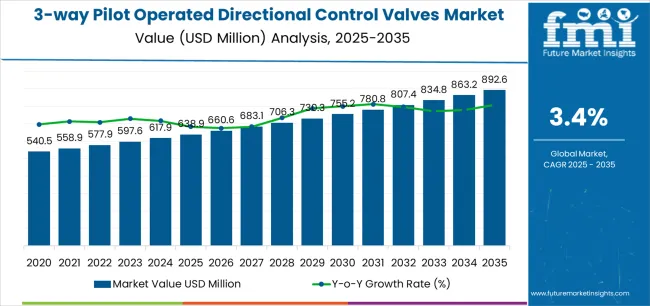
Between 2025 and 2030, the 3-way pilot operated directional control valves market is projected to expand from USD 638.9 million to USD 756.2 million, resulting in a value increase of USD 117.3 million, which represents 46.2% of the total forecast growth for the decade. This phase of development will be shaped by increasing industrial automation adoption, rising demand for precision fluid control systems, and growing availability of advanced valve technologies across manufacturing facilities and process control applications.
Between 2030 and 2035, the market is forecast to grow from USD 756.2 million to USD 892.6 million, adding another USD 136.4 million, which constitutes 53.8% of the overall ten-year expansion. This period is expected to be characterized by the advancement of IoT-enabled valve monitoring systems, the development of energy-efficient actuation technologies for industrial applications, and the expansion of automated fluid control systems across diverse manufacturing and process industries. The growing emphasis on operational efficiency and predictive maintenance will drive demand for advanced pilot operated varieties with enhanced diagnostic capabilities, improved response characteristics, and superior integration performance profiles.
Between 2020 and 2024, the 3-way pilot operated directional control valves market experienced steady growth, driven by increasing industrial modernization requirements and growing recognition of advanced fluid control technologies following extensive automation initiatives. The market developed as manufacturers recognized the advantages of pilot operated systems over conventional valve technologies and began incorporating specialized solutions designed for demanding industrial applications. Technological advancement in valve design and control integration began emphasizing the critical importance of maintaining operational precision while enhancing system reliability and improving performance characteristics across diverse industrial fluid control applications.
| Metric | Value |
|---|---|
| Estimated Value in (2025E) | USD 638.9 million |
| Forecast Value in (2035F) | USD 892.6 million |
| Forecast CAGR (2025 to 2035) | 3.4% |
From 2030 to 2035, the market is forecast to grow from USD 756.2 million to USD 892.6 million, adding another USD 136.4 million, which constitutes 53.8% of the overall ten-year expansion. This period is expected to be characterized by the advancement of artificial intelligence integration in valve control systems, the integration of predictive analytics for optimal maintenance scheduling, and the development of specialized valve configurations for high-precision industrial environments. The growing emphasis on operational excellence and digital transformation will drive demand for premium varieties with enhanced real-time monitoring capabilities, improved connectivity options, and superior automated operation characteristics.
Between 2020 and 2024, the 3-way pilot operated directional control valves market experienced consistent growth, driven by increasing awareness of advanced fluid control requirements and growing recognition of pilot operated systems' effectiveness in supporting reliable industrial operations across manufacturing facilities and process control applications. The market developed as users recognized the potential for specialized valve technologies to deliver operational advantages while meeting modern requirements for comprehensive system integration and dependable control performance. Technological advancement in pilot actuation mechanisms and digital control interfaces began emphasizing the critical importance of maintaining control accuracy while extending service life and improving user satisfaction across diverse industrial fluid control applications.
Market expansion is being supported by the increasing global demand for precision fluid control systems and the corresponding shift toward high-performance pilot operated valves that can provide superior directional control characteristics while meeting user requirements for comprehensive system integration and cost-effective industrial automation solutions. Modern manufacturers are increasingly focused on incorporating valve systems that can enhance operational efficiency while satisfying demands for consistent, precisely controlled fluid direction and optimized energy consumption practices. 3-way pilot operated directional control valves' proven ability to deliver control excellence, operational reliability, and diverse application possibilities makes them essential components for industrial automation professionals and quality-focused manufacturing operations.
The growing emphasis on operational efficiency and industrial automation optimization is driving demand for high-performance pilot operated valve systems that can support distinctive operational outcomes and comprehensive fluid control management across manufacturing processes, automation systems, and premium industrial installations. User preference for fluid control that combines functional excellence with operational reliability is creating opportunities for innovative implementations in both traditional and emerging industrial automation applications. The rising influence of Industry 4.0 principles and advanced sensor technologies is also contributing to increased adoption of specialized pilot operated valve solutions that can provide authentic operational benefits and reliable system integration characteristics.
The market is segmented by type, application, pressure range, port size, actuation method, and region. By type, the market is divided into hydraulic type, pneumatic type, and others. Based on application, the market is categorized into oil and gas, chemicals, food processing, pharmaceuticals, and others. By pressure range, the market includes low pressure (up to 150 PSI), medium pressure (150-1000 PSI), high pressure (1000-3000 PSI), and ultra-high pressure (above 3000 PSI). By port size, the market encompasses small bore (up to 1/2 inch), medium bore (1/2 inch to 2 inches), and large bore (above 2 inches). By actuation method, the market includes hydraulic pilot, pneumatic pilot, electric pilot, and manual override. Regionally, the market is divided into North America, Europe, Asia Pacific, Latin America, Middle East & Africa, and other regions.
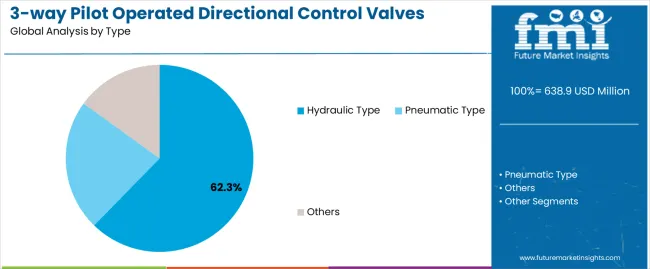
The hydraulic type segment is projected to account for 62.3% of the 3-way pilot operated directional control valves market in 2025, reaffirming its position as the leading type category. Industrial users and fluid power professionals increasingly utilize hydraulic type systems for their superior pressure handling characteristics, established performance standards, and essential functionality in diverse industrial applications across multiple manufacturing sectors. Hydraulic type valves' proven performance characteristics and established cost-effectiveness directly address user requirements for reliable fluid control and optimal operational precision in industrial and process applications.
This type segment forms the foundation of modern industrial fluid control patterns, as it represents the technology category with the greatest pressure handling potential and established compatibility across multiple hydraulic power systems. Industrial investments in advanced hydraulic technology and performance optimization continue to strengthen adoption among automation-focused users. With manufacturers prioritizing operational consistency and control reliability, hydraulic type systems align with both efficiency objectives and performance requirements, making them the central component of comprehensive industrial automation strategies.
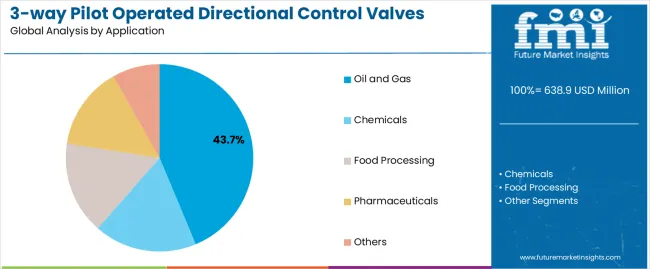
Oil and gas is projected to represent 43.7% of the 3-way pilot operated directional control valves market in 2025, underscoring its critical role as the primary application for performance-focused users seeking superior fluid control benefits and enhanced operational management credentials. Industrial operators and process engineers prefer oil and gas applications for their established operational requirements, proven industrial demand, and ability to maintain exceptional control precision while supporting versatile system integration during diverse processing activities. Positioned as essential applications for efficiency-focused operations, oil and gas offerings provide both operational excellence and reliability advantages.
The segment is supported by continuous improvement in process automation technology and the widespread availability of established industry standards that enable operational assurance and premium positioning at the industrial level. Additionally, oil and gas users are optimizing valve selections to support process-specific applications and comprehensive facility automation strategies. As industrial automation continues to advance and operators seek efficient control methods, oil and gas applications will continue to drive market growth while supporting operational efficiency and process optimization strategies.
The 3-way pilot operated directional control valves market is advancing steadily due to increasing automation requirements regarding fluid control precision and growing need for specialized valve solutions that emphasize superior operational performance across industrial segments and process applications. However, the market faces challenges, including competition from alternative valve technologies, technical expertise requirements, and initial investment cost considerations affecting adoption rates. Innovation in digital integration and advanced materials continues to influence market development and expansion patterns.
The growing adoption of 3-way pilot operated directional control valves with industrial automation connectivity and Industry 4.0 integration is enabling manufacturers to develop fluid control strategies that provide distinctive monitoring benefits while commanding automated operation and enhanced real-time data analysis characteristics. Automation applications provide superior control consistency while allowing more sophisticated operational optimization features across various industrial categories. Users are increasingly recognizing the operational advantages of digital connectivity positioning for comprehensive fluid control outcomes and technology-integrated manufacturing environment management.
Modern 3-way pilot operated directional control valve manufacturers are incorporating advanced position sensors, real-time monitoring capabilities, and automated diagnostic systems to enhance control precision, improve operational effectiveness, and meet industrial demands for intelligent fluid control solutions. These systems improve operational effectiveness while enabling new applications, including continuous system monitoring programs and predictive maintenance protocols. Advanced diagnostic integration also allows operators to support proactive operational optimization positioning and performance assurance beyond traditional valve control operations.
| Factor Type | Specific Element | Impact on Market |
|---|---|---|
| Growth Driver | Expansion of industrial automation and process control applications | Increases demand for precision fluid control systems with reliable directional performance |
| Growth Driver | Integration of smart sensors and digital monitoring systems | Enhances valve reliability, enabling predictive maintenance and real-time diagnostics |
| Restraint | High initial installation and calibration cost | Slows adoption among small-scale manufacturers and low-budget operations |
| Restraint | Technical expertise requirement for system integration | Limits adoption in facilities lacking automation-trained personnel |
| Trend | Shift toward energy-efficient, low-leakage valve designs | Supports long-term sustainability goals and operational cost reduction |
| Trend | Growing use of hybrid actuation (electro-hydraulic/pneumatic) | Expands versatility across multi-application industrial systems |
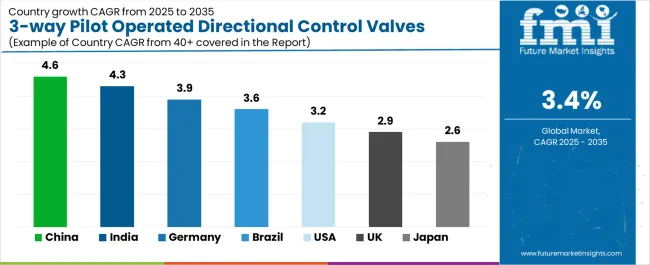
| Country | CAGR (2025-2035) |
|---|---|
| China | 4.6% |
| India | 4.3% |
| Germany | 3.9% |
| Brazil | 3.6% |
| USA | 3.2% |
| UK | 2.9% |
| Japan | 2.6% |
The 3-way pilot operated directional control valves market is experiencing steady growth globally, with China leading at a 4.6% CAGR through 2035, driven by the expanding manufacturing sector, growing automation requirements, and increasing adoption of advanced fluid control systems. India follows at 4.3%, supported by rising industrialization, expanding manufacturing base, and growing acceptance of automation technologies. Germany shows growth at 3.9%, emphasizing established engineering standards and comprehensive industrial automation development. Brazil records 3.6%, focusing on industrial modernization and manufacturing growth. The USA demonstrates 3.2% growth, prioritizing advanced automation technologies and operational optimization.
The report covers an in-depth analysis of 40+ countries top-performing countries are highlighted below.
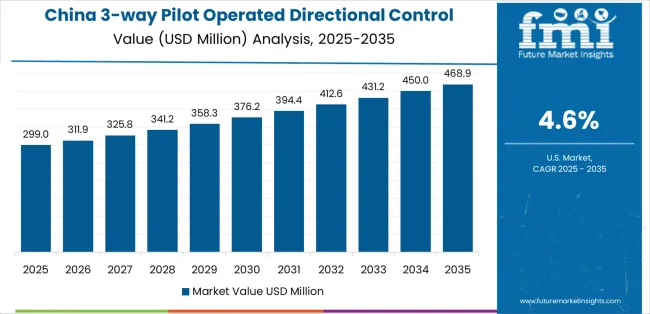
Revenue from 3-way pilot operated directional control valve consumption and sales in China is projected to exhibit strong growth with a CAGR of 4.6% through 2035, driven by the country's rapidly expanding manufacturing sector, favorable government policies toward industrial automation improvement, and initiatives promoting advanced manufacturing technologies across major industrial regions. China's position as a leading manufacturing hub and increasing focus on automation systems are creating substantial demand for high-quality pilot operated directional control valves in both domestic and export markets. Major industrial equipment companies and automation distributors are establishing comprehensive valve capabilities to serve growing demand and emerging automation opportunities.
Revenue from 3-way pilot operated directional control valve products in India is expanding at a CAGR of 4.3%, supported by rising industrialization investment, growing automation consciousness, and expanding equipment distributor capabilities. The country's developing industrial infrastructure and increasing investment in manufacturing technologies are driving demand for pilot operated directional control valves across both traditional and modern industrial applications. International equipment companies and domestic distributors are establishing comprehensive operational networks to address growing market demand for automation devices and efficient fluid control solutions.
Revenue from 3-way pilot operated directional control valve products in Germany is projected to grow at a CAGR of 3.9% through 2035, supported by the country's mature engineering standards, established industrial automation regulations, and leadership in manufacturing technology. Germany's sophisticated industrial standards and strong support for advanced automation systems are creating steady demand for both traditional and innovative pilot operated valve varieties. Leading equipment manufacturers and specialty distributors are establishing comprehensive operational strategies to serve both domestic markets and growing export opportunities.
Revenue from 3-way pilot operated directional control valve products in Brazil is projected to grow at a CAGR of 3.6% through 2035, driven by the country's emphasis on industrial development, manufacturing growth, and growing equipment distributor capabilities. Brazilian manufacturers and industrial users consistently seek performance-focused equipment that enhances operational efficiency and supports automation excellence for both traditional and modern industrial applications. The country's position as a Latin American industrial leader continues to drive innovation in specialized valve applications and industrial automation standards.
Revenue from 3-way pilot operated directional control valve products in the USA is projected to grow at a CAGR of 3.2% through 2035, supported by the country's emphasis on automation technology advancement, industrial efficiency optimization, and advanced integration requiring efficient fluid control solutions. American manufacturers and automation-focused users prioritize performance reliability and operational precision, making specialized pilot operated directional control valves essential components for both traditional and modern industrial automation applications. The country's comprehensive automation technology leadership and advancing manufacturing patterns support continued market expansion.
Revenue from 3-way pilot operated directional control valve products in the UK is projected to grow at a CAGR of 2.9% through 2035, supported by established industrial standards, mature manufacturing markets, and emphasis on operational reliability across industrial and commercial sectors. British manufacturers and automation-focused professionals prioritize quality performance and operational consistency, creating steady demand for premium valve solutions. The country's comprehensive market maturity and established industrial practices support continued development in specialized applications.
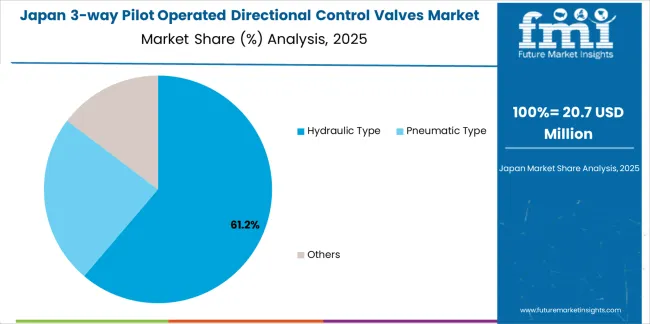
Revenue from 3-way pilot operated directional control valve products in Japan is projected to grow at a CAGR of 2.6% through 2035, supported by the country's emphasis on precision engineering, operational excellence, and advanced technology integration requiring efficient fluid control solutions. Japanese manufacturers and precision-focused users prioritize technical performance and manufacturing precision, making specialized pilot operated directional control valves essential components for both traditional and modern industrial automation applications. The country's comprehensive engineering leadership and advancing automation patterns support continued market expansion.
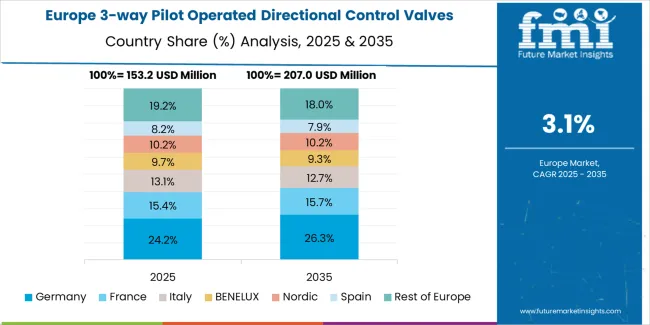
The Europe 3-way pilot operated directional control valves market is projected to grow from USD 195.4 million in 2025 to USD 267.1 million by 2035, recording a CAGR of 3.2% over the forecast period. Germany leads the region with a 38.7% share in 2025, moderating slightly to 37.9% by 2035, supported by its strong engineering regulations and demand for premium, technologically advanced valve solutions. The United Kingdom follows with 22.8% in 2025, easing to 22.3% by 2035, driven by a mature industrial market and emphasis on operational reliability and engineering performance. France accounts for 16.9% in 2025, rising to 17.4% by 2035, reflecting steady adoption of automation technologies and industrial enhancement. Italy holds 10.7% in 2025, expanding to 11.3% by 2035 as industrial automation and specialty manufacturing applications grow. Spain contributes 6.2% in 2025, growing to 6.8% by 2035, supported by expanding industrial development and automation modernization. The Nordic countries rise from 3.4% in 2025 to 3.6% by 2035 on the back of strong engineering consciousness and advanced automation methodologies. BENELUX remains at 1.3% share across both 2025 and 2035, reflecting mature, engineering-focused industrial markets.
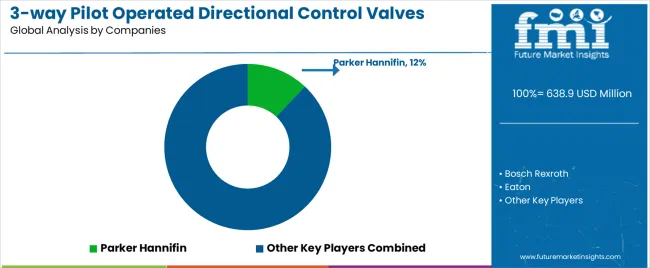
The 3-way pilot operated directional control valves market is characterized by competition among established industrial equipment manufacturers, specialized fluid power companies, and integrated automation technology providers. Companies are investing in advanced valve technologies, precision manufacturing systems, product innovation capabilities, and comprehensive distribution networks to deliver consistent, high-quality, and reliable pilot operated directional control valve systems. Innovation in response characteristics, operational efficiency optimization, and application-focused product development is central to strengthening market position and customer satisfaction.
Parker Hannifin leads the market with 12% share with a strong focus on fluid power innovation and comprehensive pilot operated directional control valve solutions, offering industrial and commercial systems with emphasis on performance excellence and technological heritage. Bosch Rexroth provides specialized industrial automation with a focus on precision engineering and advanced control networks. Eaton delivers integrated power management solutions with a focus on industrial positioning and operational efficiency. Yuken specializes in comprehensive hydraulic systems with an emphasis on precision control applications. HydraForce focuses on comprehensive industrial valve systems with advanced design and premium positioning capabilities.
The success of 3-way pilot operated directional control valves in meeting industrial automation demands, manufacturing efficiency requirements, and operational integration will not only enhance industrial performance outcomes but also strengthen global automation technology manufacturing capabilities. It will consolidate emerging regions' positions as hubs for efficient industrial equipment production and align advanced economies with comprehensive automation systems. This calls for a concerted effort by all stakeholders -- governments, industry bodies, manufacturers, distributors, and investors. Each can be a crucial enabler in preparing the market for its next phase of growth.
How Governments Could Spur Local Production and Adoption?
How Industry Bodies Could Support Market Development?
How Distributors and Industrial Equipment Players Could Strengthen the Ecosystem?
How Manufacturers Could Navigate the Shift?
| Items | Values |
|---|---|
| Quantitative Units (2025) | USD 638.9 million |
| Type | Hydraulic Type, Pneumatic Type, Others |
| Application | Oil and Gas, Chemicals, Food Processing, Pharmaceuticals, Others |
| Pressure Range | Low Pressure (up to 150 PSI), Medium Pressure (150-1000 PSI), High Pressure (1000-3000 PSI), Ultra-High Pressure (above 3000 PSI) |
| Port Size | Small Bore (up to 1/2 inch), Medium Bore (1/2 inch to 2 inches), Large Bore (above 2 inches) |
| Actuation Method | Hydraulic Pilot, Pneumatic Pilot, Electric Pilot, Manual Override |
| Regions Covered | North America, Europe, Asia Pacific, Latin America, Middle East & Africa, Other Regions |
| Countries Covered | China, India, Germany, Brazil, United States, United Kingdom, Japan, and 40+ countries |
| Key Companies Profiled | Parker Hannifin, Bosch Rexroth, Eaton, Yuken, HydraForce, and other leading 3-way pilot operated directional control valve companies |
| Additional Attributes | Dollar sales by type, application, pressure range, port size, actuation method, and region; regional demand trends, competitive landscape, technological advancements in valve engineering, precision control initiatives, operational efficiency enhancement programs, and premium product development strategies |
The global 3-way pilot operated directional control valves market is estimated to be valued at USD 638.9 million in 2025.
The market size for the 3-way pilot operated directional control valves market is projected to reach USD 892.6 million by 2035.
The 3-way pilot operated directional control valves market is expected to grow at a 3.4% CAGR between 2025 and 2035.
The key product types in 3-way pilot operated directional control valves market are hydraulic type, pneumatic type and others.
In terms of application, oil and gas segment to command 43.7% share in the 3-way pilot operated directional control valves market in 2025.






Full Research Suite comprises of:
Market outlook & trends analysis
Interviews & case studies
Strategic recommendations
Vendor profiles & capabilities analysis
5-year forecasts
8 regions and 60+ country-level data splits
Market segment data splits
12 months of continuous data updates
DELIVERED AS:
PDF EXCEL ONLINE
Slurry Valves Market Analysis - Size, Share, and Forecast 2025 to 2035
Market Share Breakdown of Aerosol Valves Industry
Aerosol Valves Market Growth and Trends 2025 to 2035
Pigging Valves Market
Blow-Off Valves Market Growth – Trends & Forecast 2025 to 2035
Isolator Valves Market
Degassing Valves Market Size and Share Forecast Outlook 2025 to 2035
Degassing Valves Industry Analysis in United States & Canada - Size, Share, and Forecast 2025 to 2035
Aerospace Valves Market Growth - Trends & Forecast 2025 to 2035
Butterfly Valves Market Analysis by Type, Mechanism, Function, Applications, and Region through 2035
Cryogenic Valves Market Growth - Trends & Forecast 2025 to 2035
Assessing Degassing Valves Market Share & Industry Trends
Automotive Valves Market Size and Share Forecast Outlook 2025 to 2035
Anti Siphon Valves Market Analysis - Size, Share, and Forecast Outlook 2025 to 2035
Surgical Heart Valves Market Size and Share Forecast Outlook 2025 to 2035
Thermal Mixing Valves Market Size and Share Forecast Outlook 2025 to 2035
Stand-Up Pouch Valves Market Size and Share Forecast Outlook 2025 to 2035
Chassis Leveling Valves Market Growth - Trends & Forecast 2025 to 2035
Automatic Gearbox Valves Market Growth - Trends & Forecast 2025 to 2035
Railway Emergency Valves Market Trends and Forecast 2025 to 2035

Thank you!
You will receive an email from our Business Development Manager. Please be sure to check your SPAM/JUNK folder too.
Chat With
MaRIA